Bagan Rising: A Sacred Wonder in Myanmar
Article and photos by James
Michael Dorsey

|
|
Bagan, Myanmar temple
complex.
|
Over 1,000 ago, two of the greatest
archeological wonders of the world began to rise almost
simultaneously in Southeast Asia: One in the steaming jungles,
the other on a sun baked plain. While the temple complex
of Angkor Wat in Cambodia has become a magnate for tourists,
its less showy cousin, in a land long shrouded in myth and
legend, is slowly unveiling itself to the modern world.
As the rising sun burns off the morning ground fog of Bagan,
Myanmar, the spires of its 2,200 pagodas, temples, and monuments
reach for the sky like spirits seeking answers while welcoming
visitors to a land long closed to the outside world.
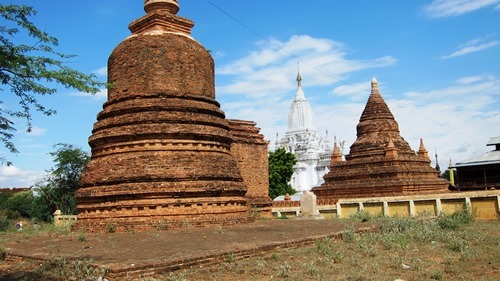
|
|
Old and new pagodas
rise to the sky.
|
To visitors riding hot air balloons
that fill the air at first light, the vast plain resembles
a giant chessboard eager to reveal ancient secrets of history
and tell stories long untold.
The royal chronicles of Burma (Myanmar)
trace the origins of Bagan to its first king, Thamaddarit
in the 2nd century. However, it was not until 849 A.D. that
the 34th king, Pyinbya established a walled city surrounded
by a moat, while most scholarly records commence with the
42nd king, Amawrahta, who began construction on the architectural
marvel left to us today.
Modern history offers evidence that
king Amawrahta was taken by the teachings of an Indian monk
named Shin Arahan and through him embraced Theravada Buddhism
with a zeal that covers most of the country to this day.
Theravada means, “Teaching of the Elders,” and is one of
three main branches of Buddhism that originated in northern
India and Nepal in the sixth century B.C., rapidly spreading
throughout Southeast Asia. Theravada Buddhism is a personal
religion that replaces deity worship with an emphasis on
very strict self-control in order to release all attachment
to the material world and achieve personal enlightenment.
During the 33 years of Amawrahta’s prosperous
reign (1044-1077 A.D.), his people believed in the acquisition
of good karma through the construction of pagodas and temples.
As the zeal of Buddhism gripped the land, the building boom
reached its zenith and included over 10,000 monuments, of
which some 2,200 still stand on the Eastern Shore of the
Irrawaddy River in central Myanmar. Marco Polo once referred
to Bagan as "a gilded city alive with tinkling bells
and the swishing sounds of monks' robes."
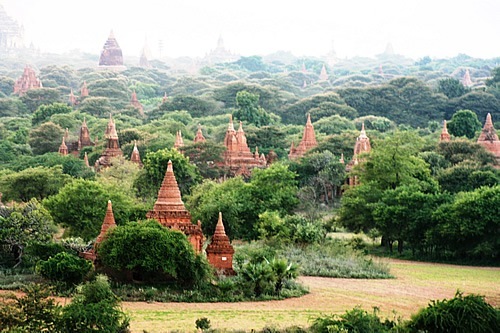
|
|
Pagodas of Bagan
|
The wooden structures are long gone
but the terra cotta bricks that provided materials for most
of the edifices have withstood history well, especially
in a land so prone to earthquakes. Most were plastered and
painted long ago, but on this windswept plain erosion has
stripped away the outer coatings, leaving behind an under
skin of brick that brings to mind the pyramids of Egypt.
The pagodas range in size from tiny garage-like structures
to enormous multi-story fortresses, some gilded, while many
still bear ancient hand painted images. Some are simple,
decorative shells; others appear to have been personal chapels
at one time, while others hold masterfully carved statuary.
All of them draw you in.
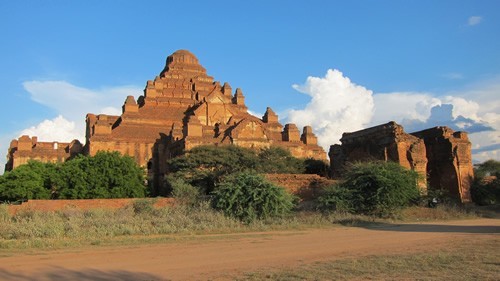
|
|
A monumental temple
with a silhouette somewhat like a pyramid.
|
While guided tours are available in
Bagan, individuals may wander about at their leisure. Many
visitors prefer to rent bicycles or motorbikes to take them
through the plain that covers over 26 square miles, (42
km). Inside, a visitor may encounter a pilgrim lost in mystical
communication. Alternatively, you might disturb the evening
den of a packrat, who bolted at my entry.
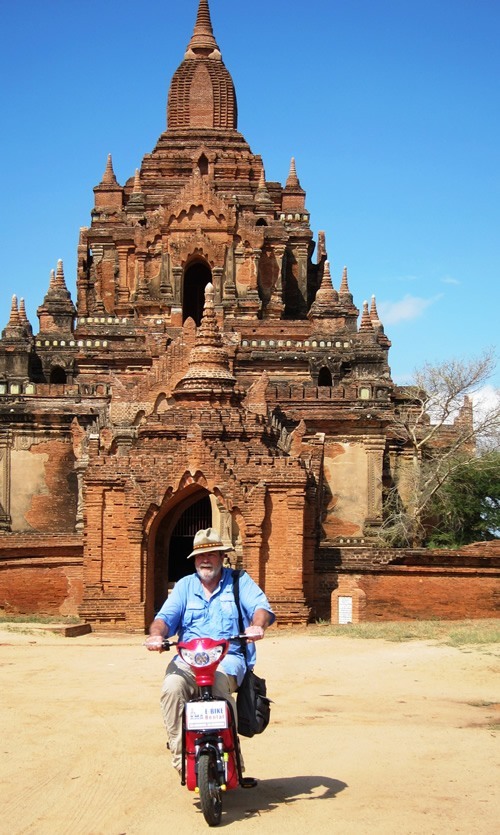
|
|
Author riding through
Bagan.
|
Remaining untouched by the religious
fervor that permeates Bagan is impossible. Many pilgrims
travel on their knees, prostrating themselves before images
of the Buddha. Whispered mantras echo through ancient halls
and tears of both joy and suffering flow freely from young
and old. Saffroned robed monks may be spotted talking on
their smartphones or photographing with their iPads, but
their faith is no less powerful. History and whispered prayers
mingle in the echoes of these ancient hallways.
The little shade on this barren plain
results in days that can fry a visitors brain, but as sunset
approaches, people gather on temple summits to watch the
spires begin their transformation from terra cotta, to orange,
and finally to a deep red, before merging with the purple
stillness of the surrounding hills. In the fading light,
dust clouds appear like billowing ghosts as herdsmen drive
their livestock home for the evening. The air fills with
the mantras of millions of cicadas chanting natures’ verses.
If spirits still reside in this land, this is when you can
sense them, as Buddhism has saturated Bagan like butter
melted into toasted bread. Nighttime in Bagan is for contemplation
and introspection, as the immensity of what one has seen
during the day begins to settle and the history and power
of personal faith washes over you.
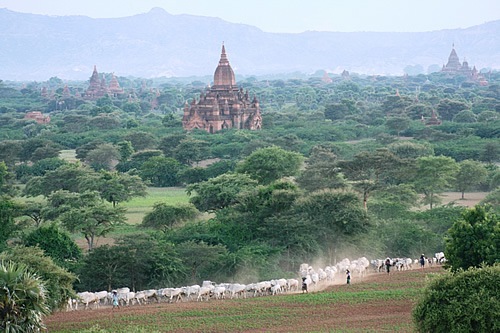
|
|
Locals driving cattle
through Bagan as evening approaches.
|
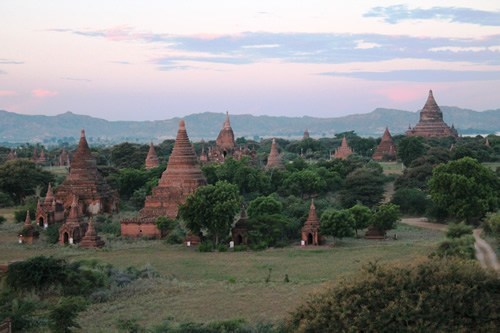
|
|
Spirits seem omnipresent
amid the many Pagodas at sunset.
|
This visitor chose a motorbike for the
day and met local villagers selling homemade shirts while
picnicking with their families. They directed me down dirt
paths imprinted only by the hooves of cattle where I encountered
rarely visited pagodas that imparted a sense of physical
presence upon entering, something I cannot explain, yet
whose actual power was beyond question. Perhaps it was the
accumulation of faith deposited over centuries, or lingering bodhisattvas who
have passed on their achievement of enlightenment to help
wandering souls like mine find their path. Either way, I
was touched by forces beyond my understanding and came away
with a sense of peace difficult to achieve in city life.
It is a rare place of power and beauty where an individual
can wander in quiet solitude.
Time stops as you traverse this
land and the only noise comes from within. No other religious
site can rival Bagan in sheer size except for Angkor Wat
in Cambodia, but Angkor is awash in people and like trying
to find quiet in an anthill. Bagan is spacious and personal,
drawing the visitor into the mystical.
Bagans’ golden era ended with the Mongol
invasion of 1287, reducing the vast plain to a mere village
of survivors that largely disappeared from world radar until
1998 when the ruling military junta realized its potential
for tourist dollars, then forcibly re-located the local
population to its current location of “New Bagan” just outside
the ancient gates. Surprisingly this unique setting has
been refused UNESCO status as a World Heritage Site because
many temples and pagodas have been re-furbished in a “non-traditional”
manner according to their criteria for admittance.
The central plains of Myanmar, home
to Bagan, are now sharing their many wonders with the outside
world. Whether you seek history, mystical belief, incomparable
architectural wonders, or simply a beautiful setting for
personal contemplation, all roads lead to Bagan.
Editor's note: For
practical tourist information on Bagan, visit Lonely
Planet.
As always, we encourage you to stay at local accommodations
so the money will be more likely to flow through to
the local economy rather than resort chains. You can
find budget accommodations and other information that
will help bring you closer to the local community
in the Bagan section of the great TravelFish.com website.
James Michael Dorsey is
an explorer, award winning author, photographer, and
lecturer. He has traveled extensively in 45 countries,
mostly far off the beaten path. His main pursuit
is visiting remote tribal cultures in Asia
and Africa.
|
